South America has played a pivotal part in the making of world-class footballers with fire, desire and grace. Carlos Tevez, Éver Banega and Juan Román Riquelme are some of the major success stories of Argentinian football, all graduating from the Boca Juniors academy in the 2000s. As of late, a new wave of Boca Juniors talent has emerged to make strides in the European game, such as Rodrigo Bentancur who transferred to Serie A giants Juventus in 2017 and Leonardo Balerdi who signed for Borussia Dortmund back in 2019 and is currently on loan in Ligue 1 with Olympique de Marseille. Another name that needs to be added to this class of quality talent from Boca Juniors is Nicolás Capaldo, a 23-year-old Argentinian midfielder.
Capaldo began his youth career at Deportivo Mac Allister before making the switch to the South American powerhouse, Boca Juniors. From that point forward, Capaldo has risen to prominence, playing in a plethora of positions and earning himself a move to Red Bull Salzburg. Nicolás Capaldo’s move can be viewed as understated, compared to moves both Rodrigo Bentancur and Leonardo Balerdi made early in their careers. While this may be the case, some could argue that taking smaller steps can lead to a greater reward. RB Salzburg is notorious for their development of young players, and his move to Austria could prove to be the perfect platform to develop, get rid of bad habits and propel himself to bigger and better things when the time is right.
So far this season, the Argentine midfielder has shown real promise of what he is capable of, as well as showcasing his tactical and positional versatility. This tactical analysis and scout report looks into what makes Nicolás Capaldo a quite interesting prospect; dissecting the strengths and weaknesses of his play on the pitch and where they can all lead him to as he approaches his physical prime as a footballer.
Position History
As mentioned prior, Nicolás Capaldo has to be used across the pitch and display his tactical flexibility — not just at RB Salzburg, but dating back to his time at Boca. Exhibited in the graphics below, we can see the various positions Capaldo has occupied this season. Most commonly, the young Argentine is used as an interior (wide central midfielder) in Matthias Jaissle’s 4-4-2 diamond, playing both on the left and right side of Salzburg’s midfield quartet. Capaldo has also featured as a right-back along with defensive midfield, on the wing and as a number ten.
Capaldo’s heat map displays where he operates during the match. We can see he likes to drift wider and play in the wide areas. From these zones, Capaldo can create and combine with teammates, while also being a threat in and around the box.
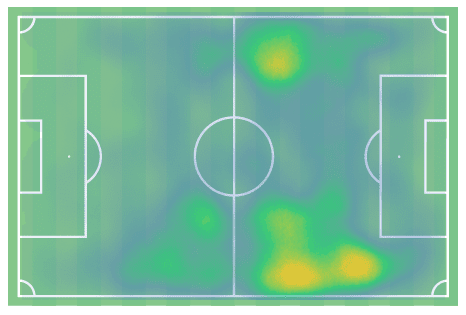
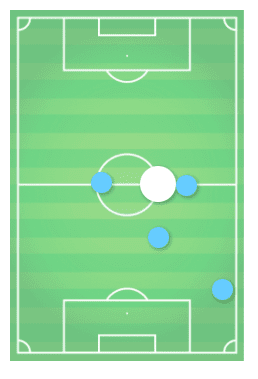
Quality In Attack
When observing Nicolás Capaldo, a standout quality that is ingrained in his game is his assertiveness throughout his actions, which are positive and negative, and this element will be discussed throughout. From midfield areas, Capaldo loves to give the attacker the space and runs in-behind, especially down the half-spaces. An example of Capaldo executing this skill can be seen in his performance against WSG Tirol in the Austrian Bundesliga.
Here, Antoine Bernède is in possession, stationed on the left side of the field, ready to fire a forward pass into Brenden Aaronson. Capaldo, positioned on the right, is watching the play develop.
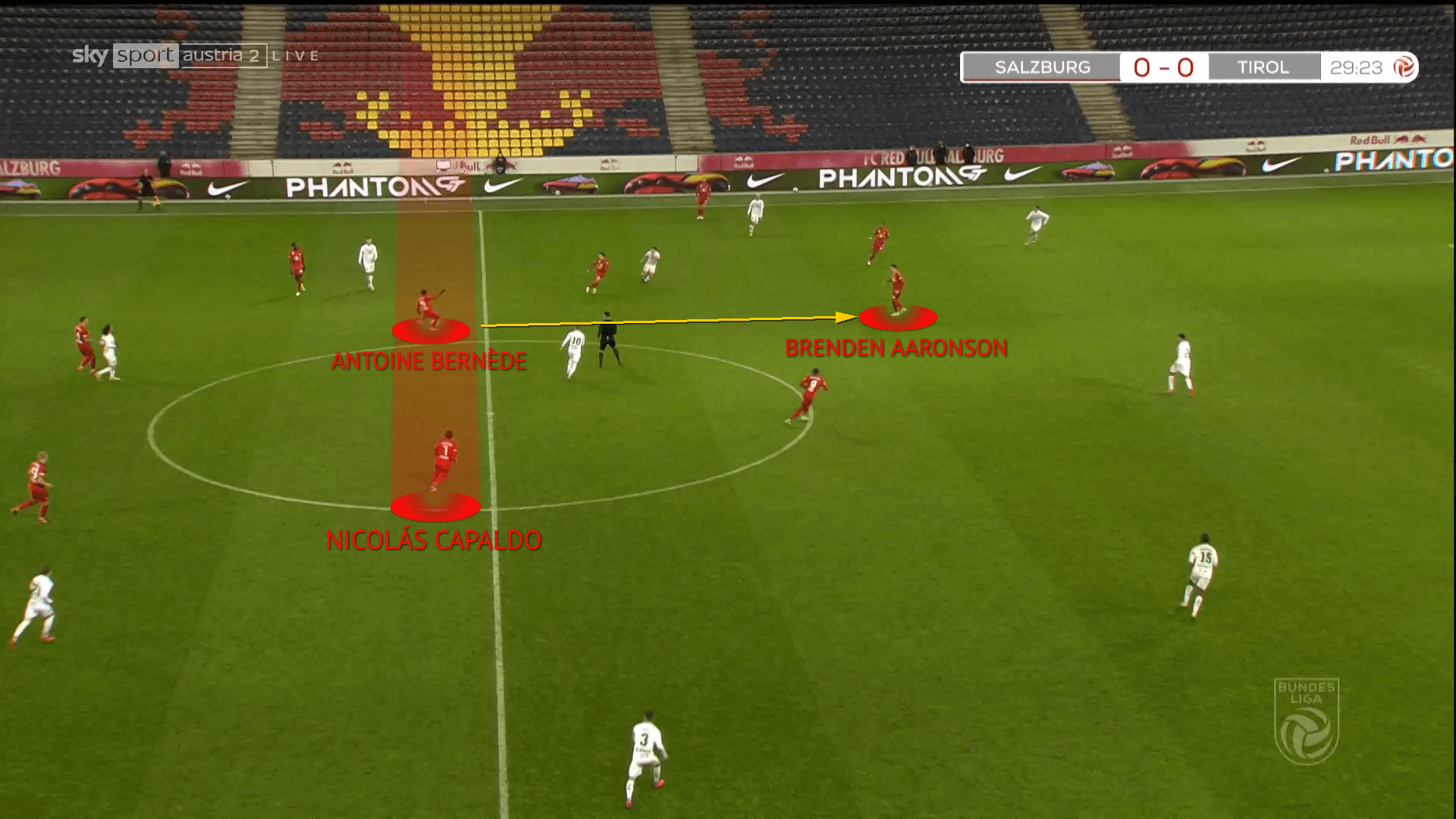
Aaronson receives the pass and drives forward. Centre-forward Junior Adamu adjusts his position and moves slightly closer to Aaronson, and because of this, occupies the opposition centre-back, which creates space on the right-hand side. Aaronson sends Adamu a square pass and while this is taking place, Capaldo aggressively attacks the space created by his teammates. Adamu controls the ball and slides a through pass to Capaldo, who eventually goes through on goals and scores from this opportunity.
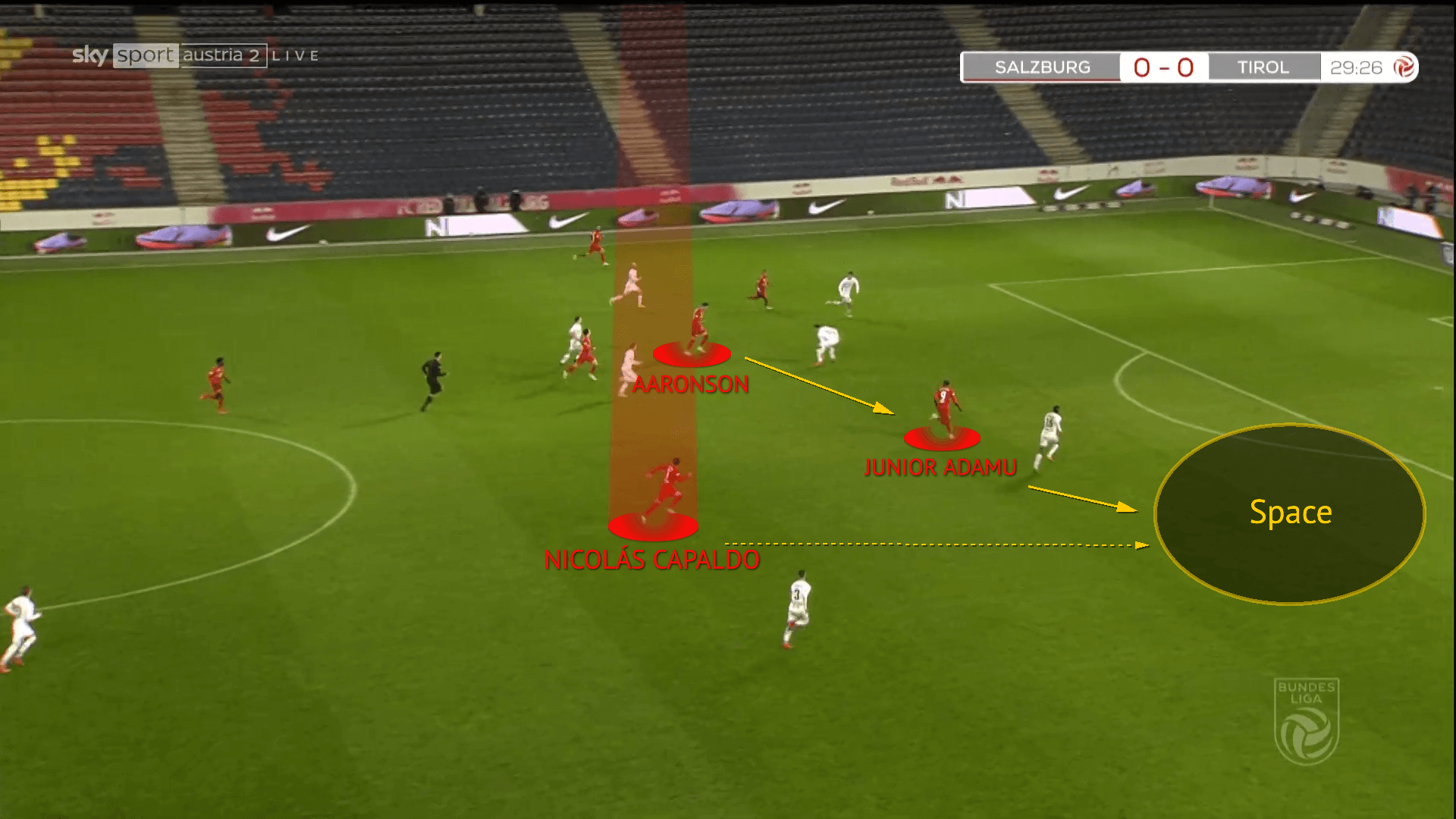
Nicolás Capaldo’s assertiveness can also be seen through his receiving and passing at times. Capaldo likes to complete some passing exchanges with teammates within one touch. When receiving the ball, the Salzburg midfielder shows a good variation to allow play to progress quickly, as he can swiftly relay a pass with his chest and head before suddenly bursting into open space. Capaldo’s ability to work within one touch so well plays a major role in his link play. From the wide spaces, the 23-year-old does well to bounce the ball with teammates; this is beneficial, as this helps ball progression and helps sustain attacks in the final third besides bringing attacks to life when suffering from a creative roadblock. Capaldo’s passing can be too assertive, as his primary aim is to lay off and hit the box as soon as possible and his touches can become loose and heavy. To truly develop his midfield play, his capability of knowing when to slow down and speed up must heighten.
While Capaldo is creative regarding his variation of receiving and off-ball movement, he showed no actual signs of being an out-and-out creator from midfield. Not that he cannot pass, Capaldo has shown flair with his distribution, as he has a nice disguised pass in his arsenal. However, some of Caplado’s long-range efforts can be inconsistent, as he may under/over hit when directing at a target. This inconsistency can also be said about his final third shot-creating; the passing target may be the right intention, but the execution is not always correct, hence the target is missed. Regardless, this is not his role within RB Salzburg’s team, but his lack of threading balls through the eye of a needle, like for example Kevin De Bruyne or Toni Kroos, shows us what kind of player he can be in years to come, in an attacking sense.
With his link play and semi-decent passing range, as well as variation receiving and attacking space from deep, Capaldo is showing the signs of an “attacking facilitator” rather than a creator or a finisher of the attack. Upon observation, Capaldo has not shown the creativity threshold for being a team’s number one creator but shows good signs of being a secondary creative player with his off-ball running, especially on the left of a 4-3-3 or as an interior in a 4-4-2 diamond. The only scenario in which I see Capaldo as a number 10 is if he attacks the box and contributes on a goal-scoring front while providing decent-to-good creativity in this zone, similar to Thomas Müller at Bayern Munich.
Defensive Evaluations
When evaluating Nicolás Capaldo’s defensive skill and value, the stats suggest nothing but a good thing. With the data provided by Statsbomb, Capaldo accumulates 3.08 tackles per 90, with the league averaging to around 2.09, along with 3.48 interceptions per 90 (league average equals 2.55). The data suggests Capaldo is active on the defensive side of the ball and when viewing his actions on the field, his defensive actions are clear to see. Capaldo’s assertiveness is a visible factor within his game, as he gets a lot of energy and will put in the hard yards and track back when needed, which is a plus point on his part.
His pressing nature is extremely useful for an RB Salzburg side that wishes to inflict their counter-pressing style onto their opponents and win the ball back high up the field. While being a player who has no qualms about putting in a shift for the good of the team, Capaldo suffers from technical issues when defending.
When discussing Capaldo’s attacking quality, his assertiveness and eagerness was a benefit, but can also come at a cost, and this same notion can be repeated about his defensive proficiency. When pressing, the Salzburg midfield can be slightly careless regarding the angle he presses the opposition ball carrier. Capaldo also faces some issues with his 1v1 defending. His flatfeet can leave him vulnerable when in these types of situations, due to him planting his feet firmly into the ground, he cannot adjust his body quickly enough, and this issue is quite clear against opposition players that make swift and elusive movements when dribbling.
Here is a perfect example of Capaldo’s defensive strengths and shortcomings. Daouda Guindo is occupying the opposition player in possession on the left-hand side. Just behind the ball carrier is another player, ready to provide an overlapping outlet. In this situation, Capaldo shows good positional sense, as he is ready to react to the overlap, besides denying a pass to the opposition central striker with his cover shadow.
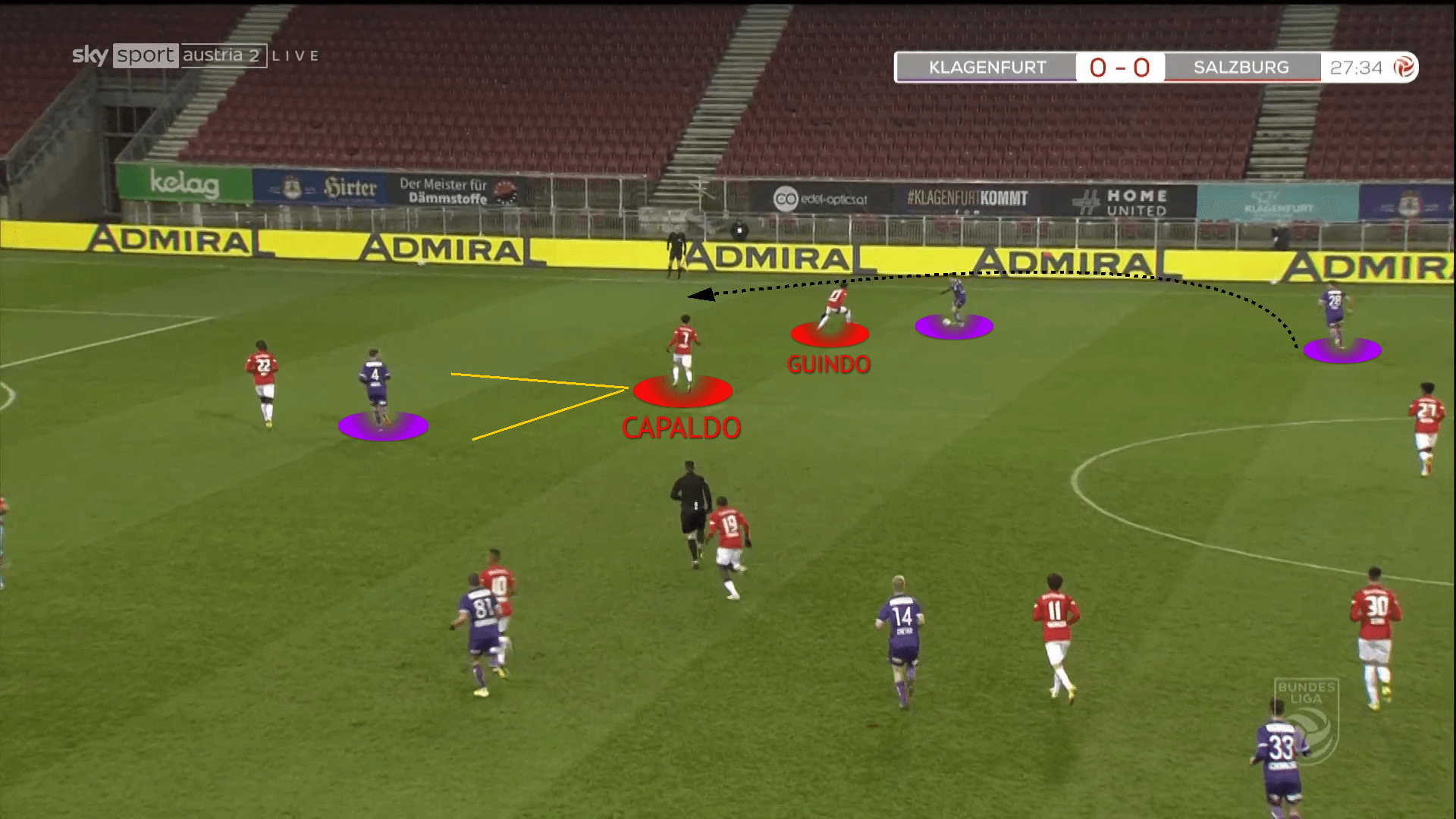
The player providing the supporting run eventually receives the ball, and Capaldo makes his way to face him 1v1. Here is where his issues are more prevalent. Capaldo attempts to anticipate his maker’s movement and as he attempts to retrieve the ball, his marker simply bypasses him and progresses forward.
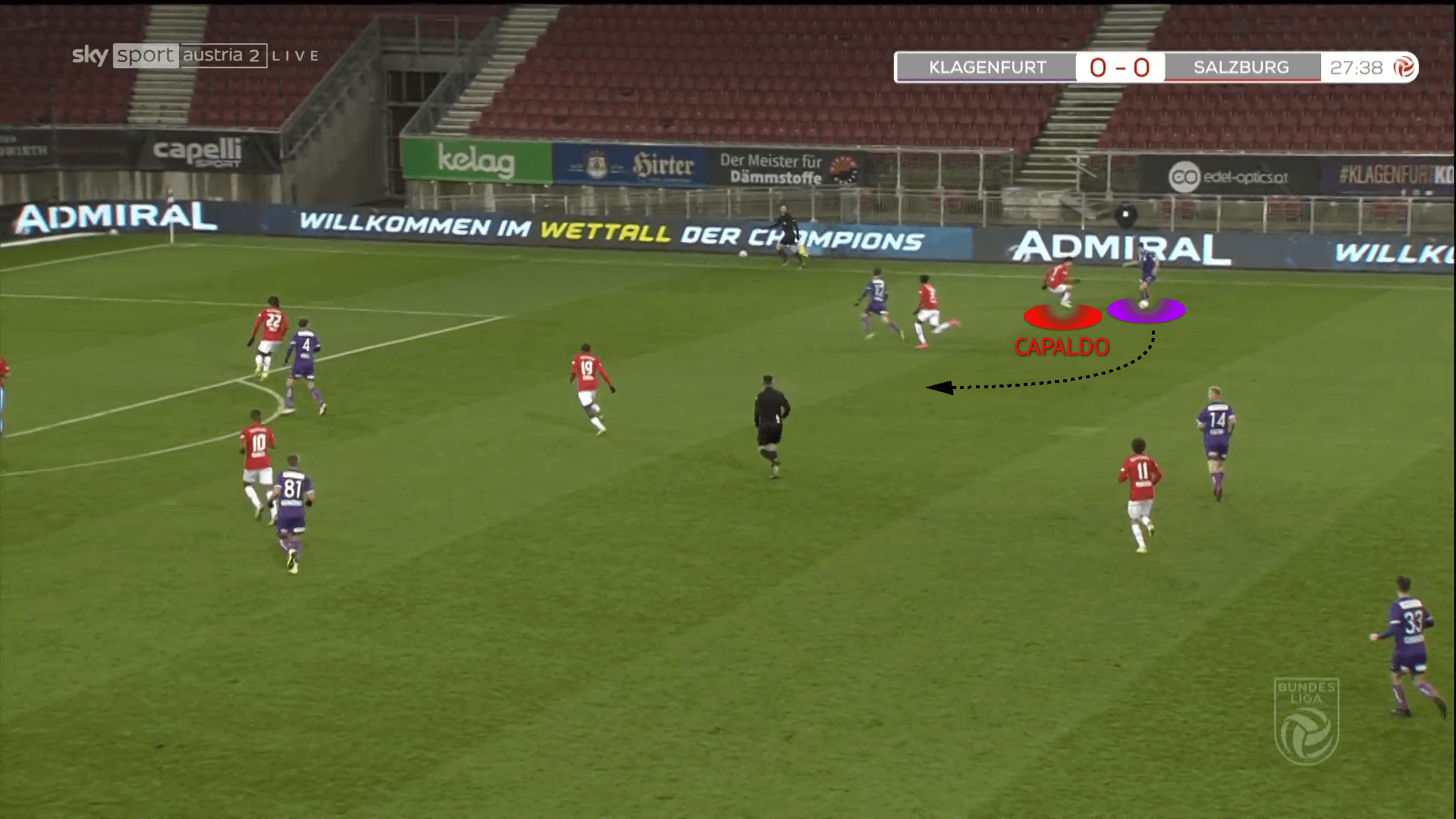
Space Interpretation
When playing in midfield, players need to process what is occurring around them and allow the stimulus they have observed, to guide them when making their next action, either with or without the ball. With this being said, Nicolás Capaldo occasionally scans over his shoulder before receiving passes, but not the type of frequency of a Martin Ødegaard, whose actions are crisp, yet meaningful because of his understanding of what is around him through scanning.
Here, the Argentine is placed in the middle third, observing play occur in front of him. While his teammates are exchanging passes, Capaldo is simply ball-watching and not taking mental notes, planning his next decision when he finally gets the ball.
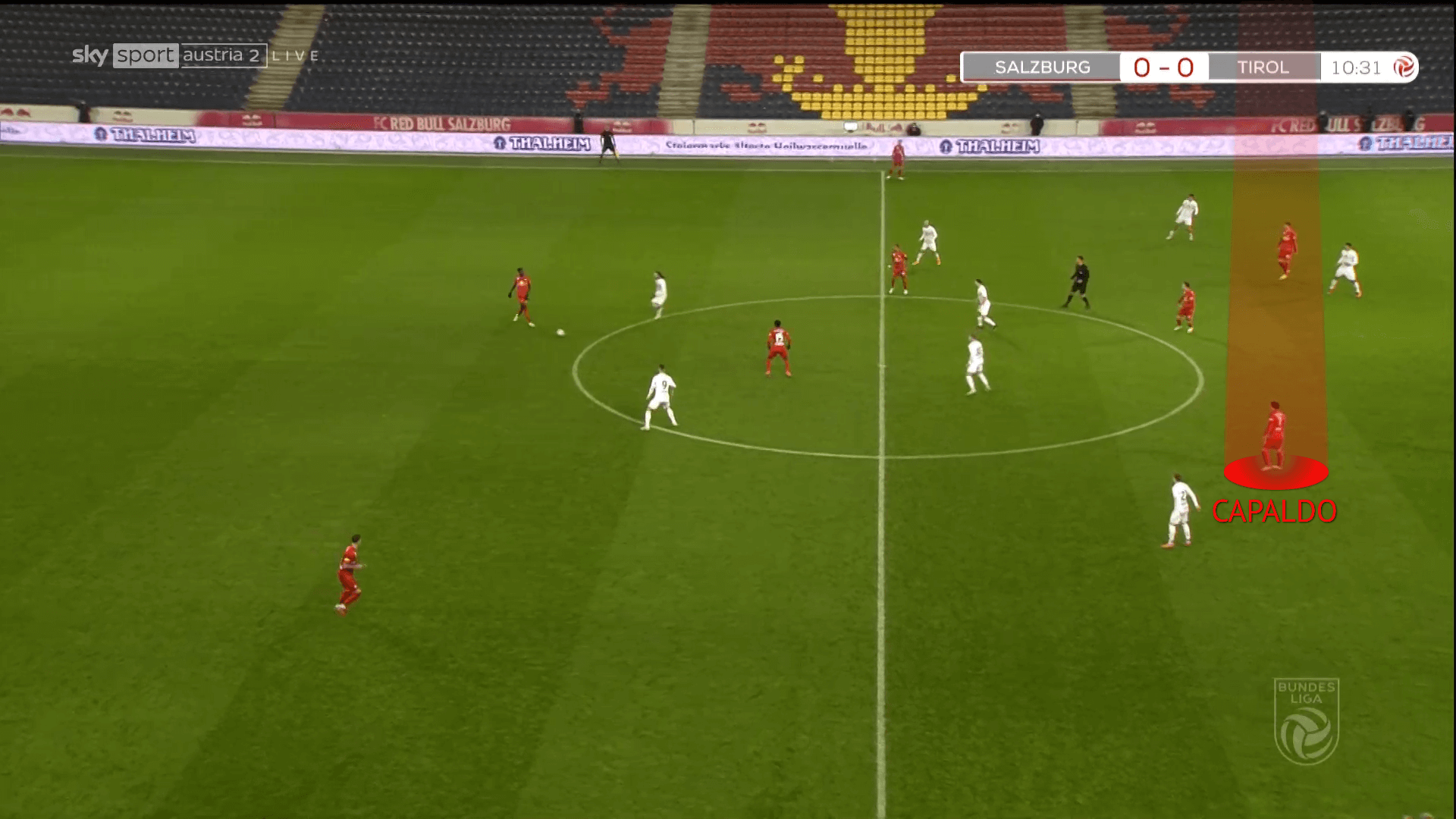
The Salzburg centre-back on the ball is ready to fire a pass to Capaldo in between the lines. During this situation, Capaldo is in a prominent position to either turn and face the space behind or take a touch and pass to Aaronson on his right side. Instead, he plays a first-time ball into Kamil Piątkowski. This sequence is a great example of how the understanding of surroundings can increase decision making. Ultimately, Capaldo did not make a wrong decision by passing the ball back to a defender rather than progressing the play himself, but these kinds of events and what takes place can help separate the decent from the good and the good from the great.
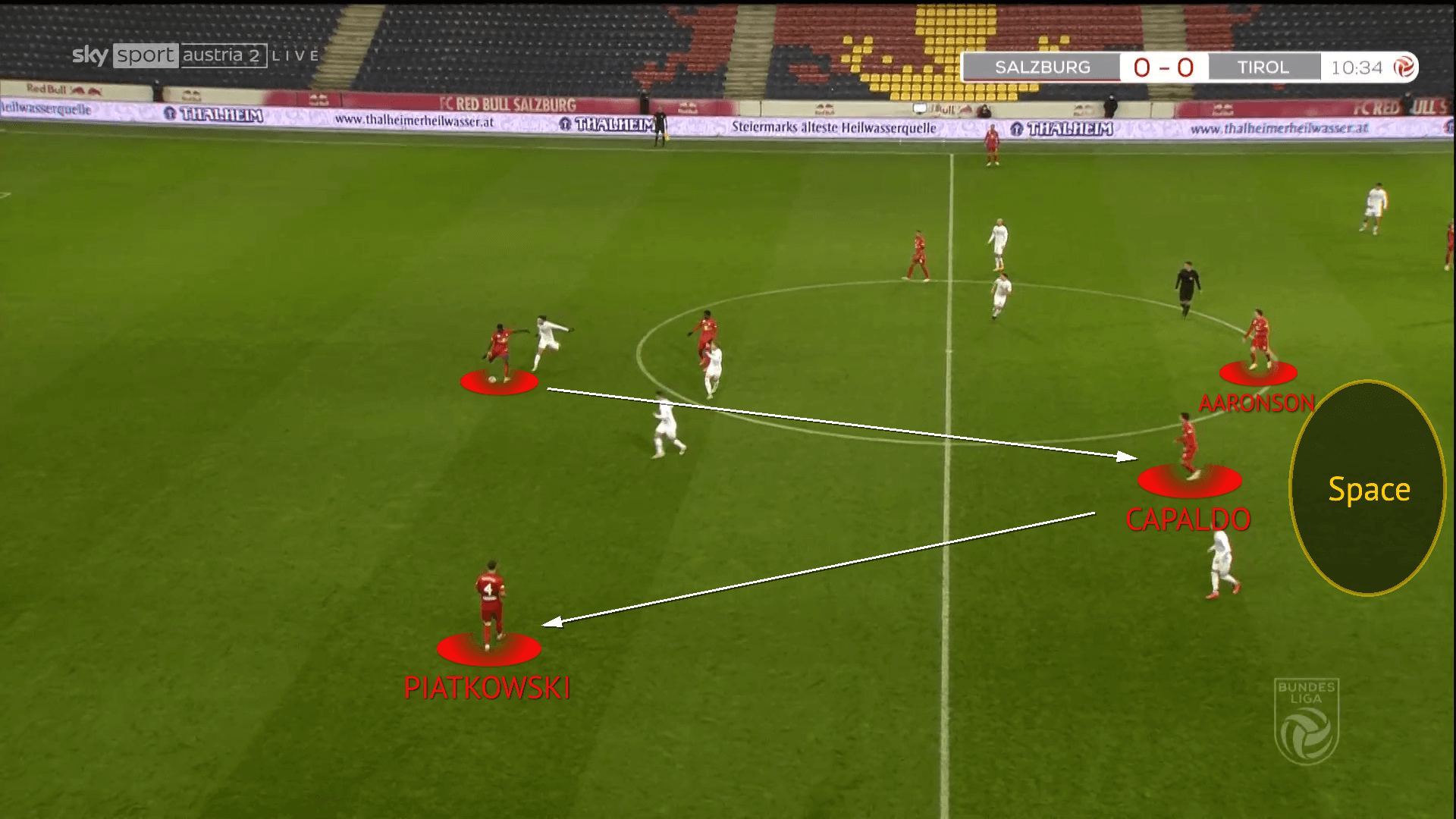
An important aspect of Capaldo’s game that needs some adjustment is his ability to position himself according to his teammates to enhance the team’s overall play.
Here, Capaldo positioned out wide, passed the ball to a teammate positioned more centrally and play continued. As Salzburg circulates the ball, from his wide position, Capaldo takes a few steps backwards, towards the sideline.
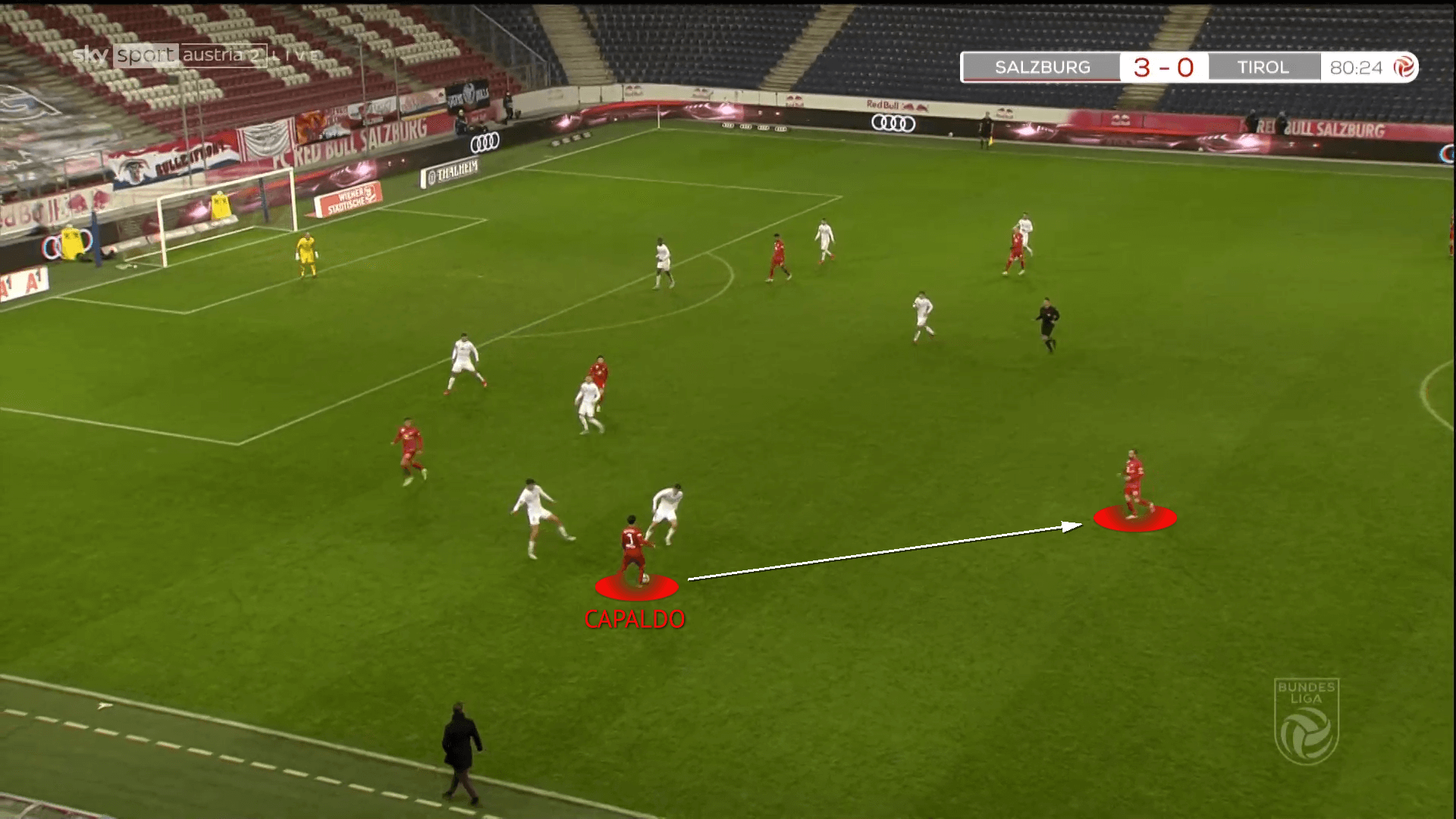
Capaldo’s slight backwards steps have created an issue; he is now operating on the same vertical line as the full-back to the left of him and denies that pass. A better option would have been to operate slightly further forward and occupy the space just in front of him. As he does not do this, the opposition can now condense the space and deny all forward passes.
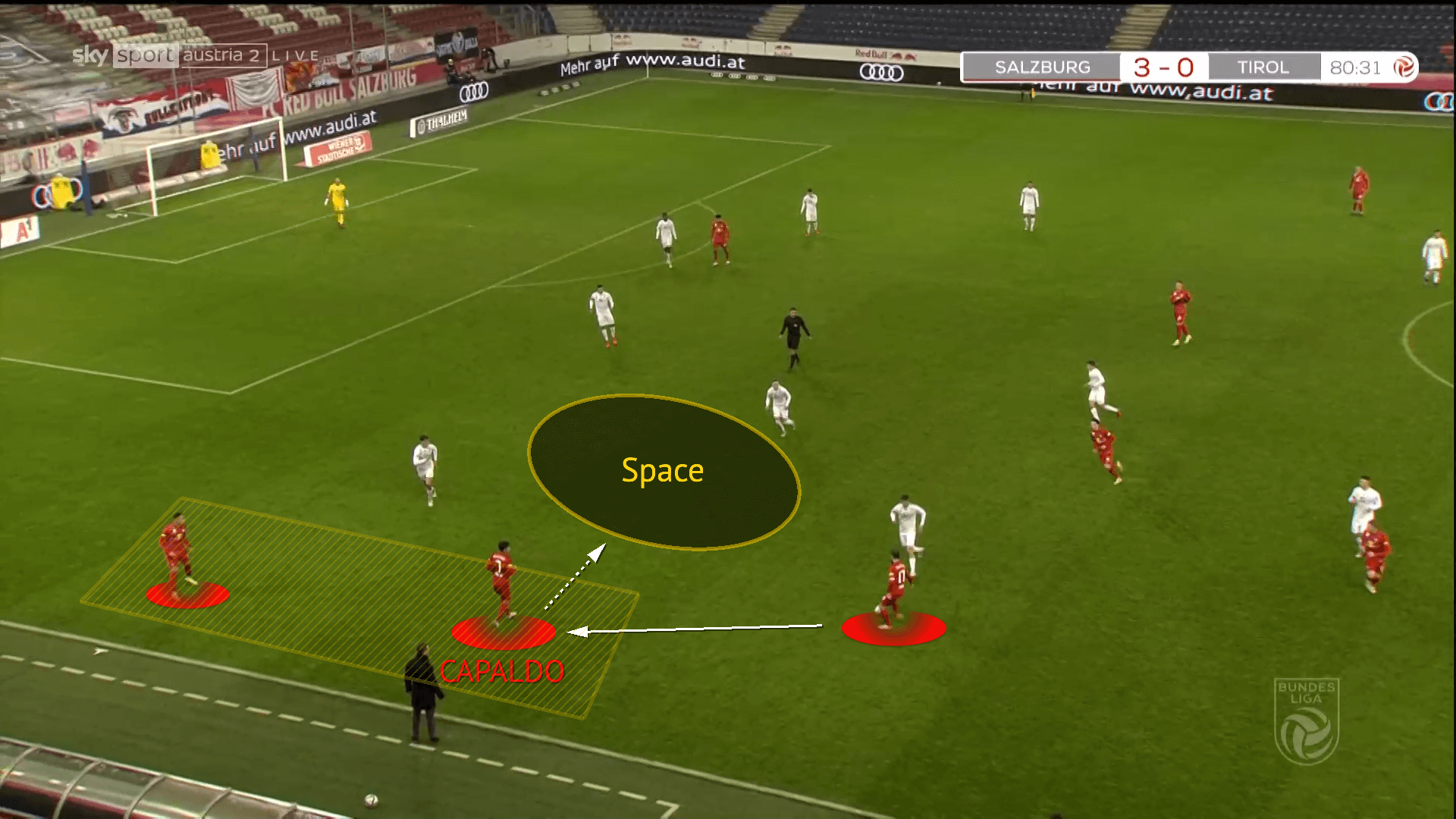
Conclusion
Nicolás Capaldo, the Boca Juniors graduate following the pathway led by some other South American greats, is an intriguing player, based upon his mixture of skills. A player that plays at a high tempo and a forward eye, consistently attempting to make runs into the box with much conviction. His will and desire do not stop there; Capaldo has a great work rate — willing to chase, retrieve and cover within his counter-pressing team.
For all his positives, he presents some negatives, most of which you might think would’ve been eliminated at his 23 years of age. Capaldo must grasp when to create a passing angle and when to hold position to create space for others, as well as when to slow down his play, as this can lead to wayward touches and execution.
All players have imperfections, and Nicolás Capaldo is no different. However, with the strengths he has shown, the young midfielder can still be a useful player in a few tactical roles within the top five leagues in Europe and now, playing at a higher level can only elevate his game.

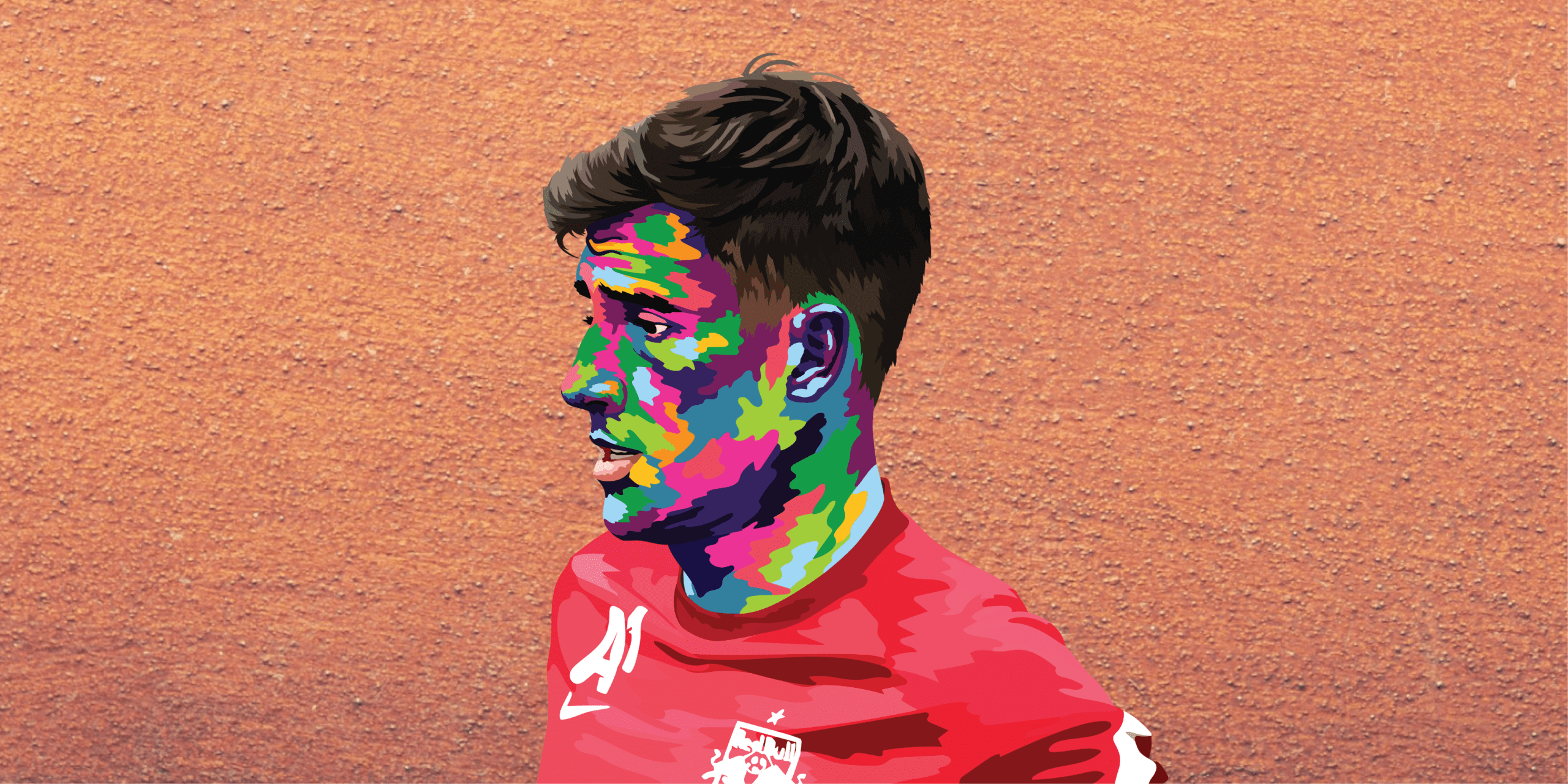




Comments